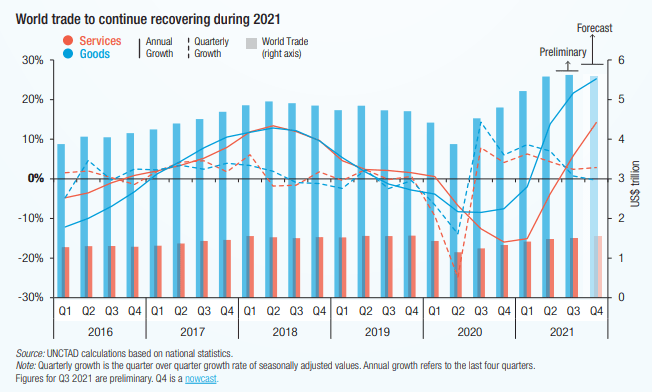UNCTAD: 6 trends in world trade

The United Nations Conference on Trade and Development (UNCTAD) described six trends in world trade in 2021 on Tuesday.
First of all, the positive trend in international trade in 2021 is largely the result of the strong recovery in demand due to the easing of pandemic restrictions, economic stimulus packages and increases in commodity prices.

However, the forecast for 2022 remains highly uncertain due to several factors.
World trade trends
-
The slowdown in the economic recovery.
The strong economic recovery of the first half of 2021 has slowed down during the second half of 2021.
In particular, China‘s economic growth in the third quarter of 2021 was below expectations and lower than in previous quarters.
Lower-than-expected economic growth rates are generally reflected in more depressed global trade trends.
Rising commodity prices and inflationary pressures can also negatively affect the economic outlook and international trade flows.
Additionally, many economies, including those in the European Union, continue to face disruptions related to Covid-19.
These disruptions can negatively affect consumer demand and ultimately be reflected in business statistics for the coming quarters.
-
Interruptions in logistics networks and increased shipping costs.
The 2021 recovery has been marked by large and unpredictable shifts in demand, which have resulted in increased stress on supply chains.
Logistical disruptions and high fuel prices have further contributed to supply shortages and rising shipping costs.
In particular, the delays in major supply chain hubs that have characterized most of 2021 could continue into 2022 and thus adversely affect trade and reshape trade flows around the world.
-
Global shortage of semiconductors.
Trade in some major sectors showed signs of weakness in 2021 due to a shortage of semiconductors.
Since the start of the Covid-19 pandemic, the semiconductor industry has faced headwinds due to unexpected increases in demand and persistent supply constraints.
The semiconductor shortage has already affected many industries, particularly the automotive sector.
If it persists, this shortage could continue to negatively affect production and trade in many manufacturing sectors.
-
Geopolitical factors and regionalization of trade flows.
Ongoing geopolitical tensions between some of the major economies may lead to new trade confrontations with major repercussions for international trade flows.
Furthermore, the implementation of regional trade agreements, such as the African Continental Free Trade Area and the Regional Comprehensive Economic Association, is expected to influence world trade patterns. Regional trade within Africa and within the Asia-Pacific area is expected to increase, but also by diverting trade from other routes.
-
Government policies that affect international trade.
Governments increasingly support national socio-economic and strategic goals.
Efforts towards a more socially and environmentally sustainable economy can affect international trade.
For example, government policies may be aimed at discouraging trade in varieties of high-carbon products or goods linked to the exploitation of labor or the environment.
Many governments may become more interested in supporting strategic goals such as those related to food safety or the indigenous growth of particular industries (eg, transportation and semiconductors).
Such policies would affect international trade patterns.
-
Debt charges.
Additional indebtedness by governments to sustain their economies during the Covid-19 crisis could pose continued risks of financial instability, especially in the event of global inflationary pressures.
Rising interest rates and debt service obligations could create instability in many countries and negatively affect investment and international trade flows, especially for developing countries whose fiscal policy space is limited.
![]()

